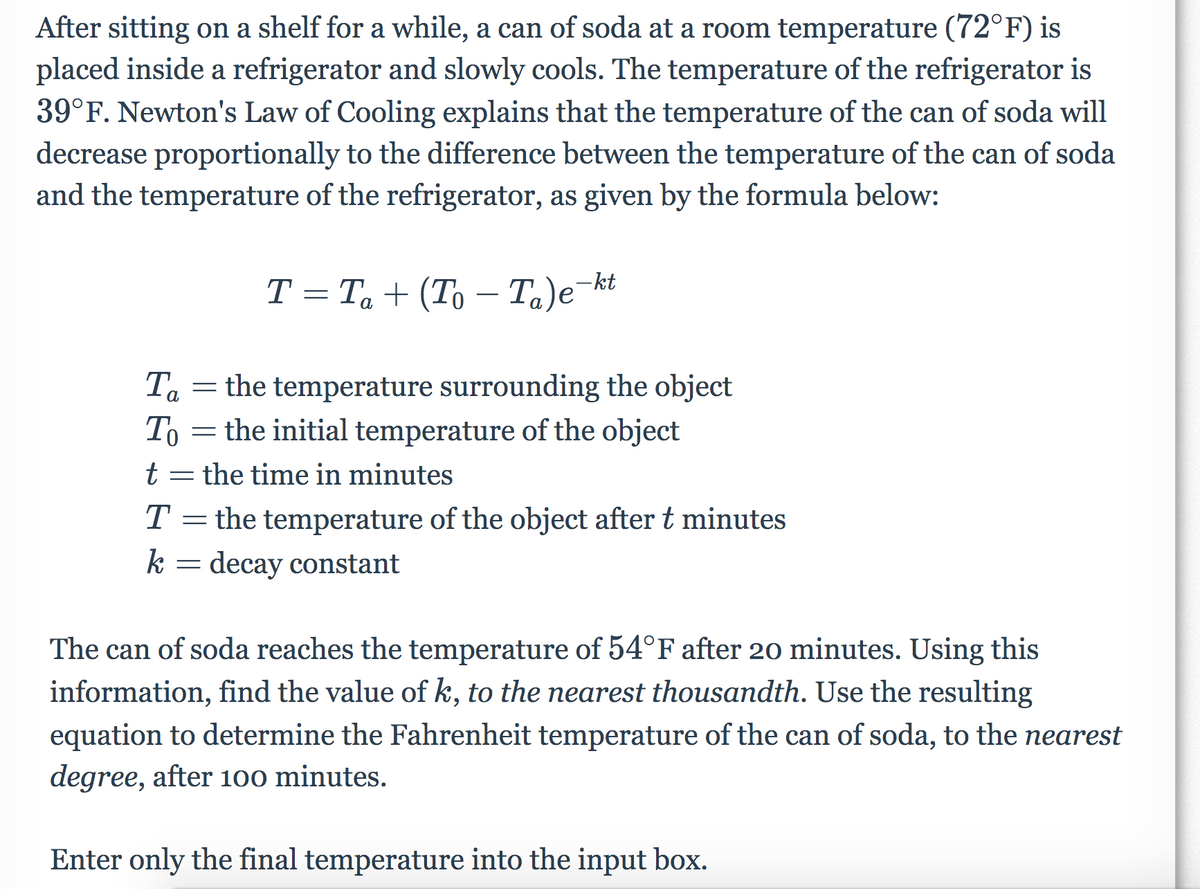After sitting on a shelf for a while, a can of soda at a room temperature (72°F) is placed inside a refrigerator and slowly cools. The temperature of the refrigerator is 39°F. Newton's Law of Cooling explains that the temperature of the can of soda will decrease proportionally to the difference between the temperature of the can of soda and the temperature of the refrigerator, as given by the formula below: T = Ta + (To –- Ta)e-kt Ta the temperature surrounding the object To = the initial temperature of the object
After sitting on a shelf for a while, a can of soda at a room temperature (72°F) is placed inside a refrigerator and slowly cools. The temperature of the refrigerator is 39°F. Newton's Law of Cooling explains that the temperature of the can of soda will decrease proportionally to the difference between the temperature of the can of soda and the temperature of the refrigerator, as given by the formula below: T = Ta + (To –- Ta)e-kt Ta the temperature surrounding the object To = the initial temperature of the object
Algebra: Structure And Method, Book 1
(REV)00th Edition
ISBN:9780395977224
Author:Richard G. Brown, Mary P. Dolciani, Robert H. Sorgenfrey, William L. Cole
Publisher:Richard G. Brown, Mary P. Dolciani, Robert H. Sorgenfrey, William L. Cole
Chapter9: Systems Of Linear Equations
Section9.6: Wind And Water Current Problems
Problem 14OE
Related questions
Topic Video
Question

Transcribed Image Text:After sitting on a shelf for a while, a can of soda at a room temperature (72°F) is
placed inside a refrigerator and slowly cools. The temperature of the refrigerator is
39°F. Newton's Law of Cooling explains that the temperature of the can of soda will
decrease proportionally to the difference between the temperature of the can of soda
and the temperature of the refrigerator, as given by the formula below:
T = Ta + (To – Ta)e-kt
the temperature surrounding the object
To
To = the initial temperature of the object
t = the time in minutes
T = the temperature of the object after t minutes
k = decay constant
The can of soda reaches the temperature of 54°F after 2o minutes. Using this
information, find the value of k, to the nearest thousandth. Use the resulting
equation to determine the Fahrenheit temperature of the can of soda, to the nearest
degree, after 100 minutes.
Enter only the final temperature into the input box.
Expert Solution
This question has been solved!
Explore an expertly crafted, step-by-step solution for a thorough understanding of key concepts.
This is a popular solution!
Trending now
This is a popular solution!
Step by step
Solved in 3 steps with 24 images

Knowledge Booster
Learn more about
Need a deep-dive on the concept behind this application? Look no further. Learn more about this topic, algebra and related others by exploring similar questions and additional content below.Recommended textbooks for you

Algebra: Structure And Method, Book 1
Algebra
ISBN:
9780395977224
Author:
Richard G. Brown, Mary P. Dolciani, Robert H. Sorgenfrey, William L. Cole
Publisher:
McDougal Littell

Intermediate Algebra
Algebra
ISBN:
9781285195728
Author:
Jerome E. Kaufmann, Karen L. Schwitters
Publisher:
Cengage Learning

Algebra for College Students
Algebra
ISBN:
9781285195780
Author:
Jerome E. Kaufmann, Karen L. Schwitters
Publisher:
Cengage Learning

Algebra: Structure And Method, Book 1
Algebra
ISBN:
9780395977224
Author:
Richard G. Brown, Mary P. Dolciani, Robert H. Sorgenfrey, William L. Cole
Publisher:
McDougal Littell

Intermediate Algebra
Algebra
ISBN:
9781285195728
Author:
Jerome E. Kaufmann, Karen L. Schwitters
Publisher:
Cengage Learning

Algebra for College Students
Algebra
ISBN:
9781285195780
Author:
Jerome E. Kaufmann, Karen L. Schwitters
Publisher:
Cengage Learning



Trigonometry (MindTap Course List)
Trigonometry
ISBN:
9781337278461
Author:
Ron Larson
Publisher:
Cengage Learning